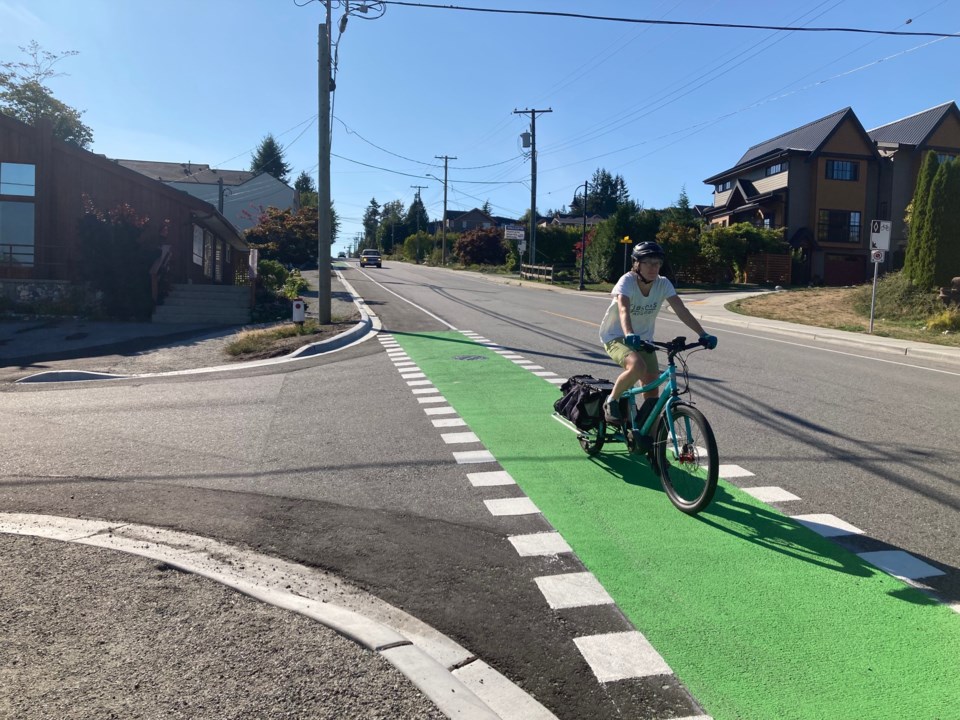Drivers and cyclists using Gibsons’ North Fletcher Road have new pavement markings to pay attention to. Where that road meets Gibsons Way, the driving lane has an area marked in green which indicates an intersection “bike box” space for cyclists.
The stop line for vehicles is behind the green paint.
“This creates a refuge area for bikes in front of vehicles. It allows them to pull out and wait for a safe point to cross,” Gibsons’ director of infrastructure services, Dave Newman, said in an interview with Coast Reporter.
It also gives cyclists a bit of a “head start to navigate the intersection before vehicle traffic starts moving,” said Newman.
The addition meets Ministry of Transportation and Infrastructure standards for design and placement. It is the first one on the Coast and the municipality will be assessing how well it functions before considering more. Based on that assessment and future situations, Newman said, “where they are appropriate, we will use them.”
Jody Schick of Transportation Alternatives Sunshine Coast (TRaC), a group working to create more sustainable local transportation alternatives about the Town’s efforts, called the bike box a step in the right direction.
“And of course we would like to see more,” said Schick.
A “life-long cyclist” who resided on the Lower Mainland before moving to the Coast 20 years ago, Schick said that in other communities, bike boxes are usually placed at traffic control lights.
“That is because signalized intersections are typically the most difficult ones to navigate as a cyclist,” said Schick. “It would be nice to see a bike box at a signalized intersection here to see how well it would work and to help ensure drivers remember what the rules of the road are around them.”
Sechelt is taking a wait and see approach on bike boxes. Communications manager Julie Rogers wrote in an email: “As Sechelt doesn’t operate any signalized intersections, we won’t be doing any bike boxes. It is our understanding that Gibsons is working with the Ministry on this. We will be watching with interest to see how well they work together so we might do something similar.”
The changes on North Fletcher are part of the town’s initiatives to improve the safety of its cycling infrastructure. These have also included green painted bike lanes along Gibsons Way and in other areas. Newman said “green markings within a bike lane signify a potentially high traffic conflict area” to both cyclists and motorists.
Schick agrees that adding highly visible markings that make drivers more aware when they are travelling alongside cyclist lanes should be a town priority. He said that one of the most common traffic accidents involving cyclists occurs when a vehicle making a right turn crosses a bike lane and “cuts off” a cyclist. He said he hopes that having the green lane markings will remind drivers to complete right hand shoulder checks and change lanes only when safe to do so.
Earlier this year, Gibsons received a $675,000 grant from the province to improve its active transportation infrastructure. In addition to paying for the new pavement markings, this funding will help build new pathways for both cyclists and pedestrians on Reed, Payne and Gower Point roads as well as Venture Way. It will also cover the costs of new signage, public toilets, electric bike charging stations and bike parking spots.
“I believe we are getting really good value for these dollars as we are creating a safe and continuous cycling network throughout the town,” said Newman.
“While every bike route may not be suitable for every cyclist, with the network, there will be options where cyclists of different abilities will feel comfortable riding between upper and lower Gibsons and to key points within the town.”
“The big thing TRaC is pushing for is greater separation between cyclists and motorists on busy routes,” said Schick. “What you build in between intersections encourages people to consider cycling and attracts them to use it. What you do at intersections helps keeps them safe.”



